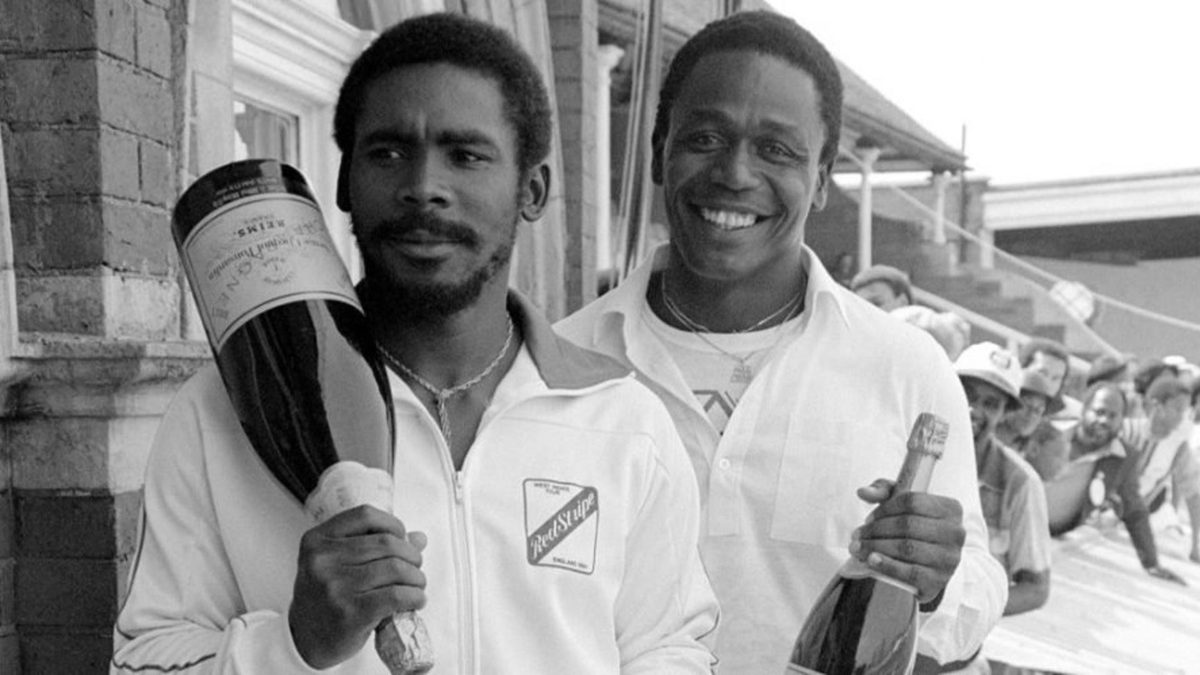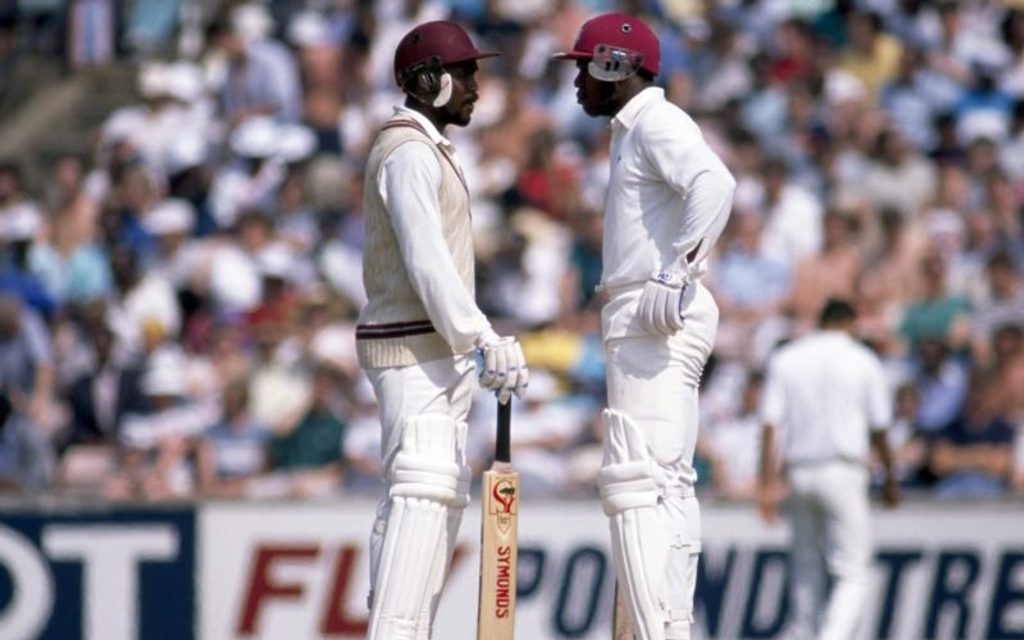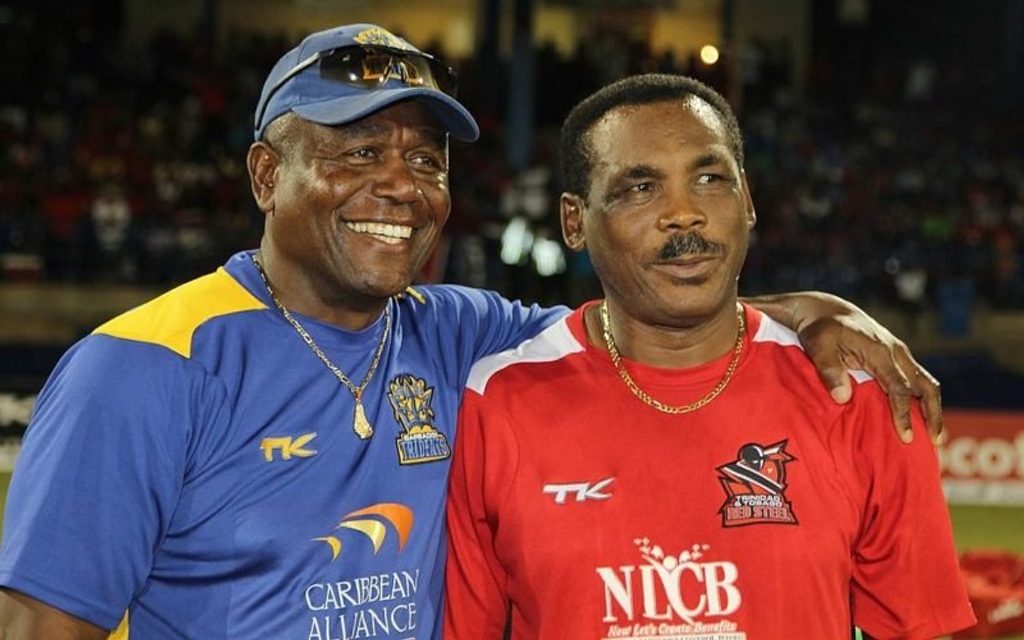
Desmond Haynes and Gordon Greenidge, one of cricket’s most iconic opening partnerships, recall the good times and the bad.
First published in 2017
First published in 2017
“Anyway, what do you want to talk about?” Desmond Haynes, I had been promised, would be the friendly one. But we seem to have got off on the wrong foot.
“So we do an interview with All Out Cricket,” he had said, “we get nothing for it, you get our knowledge and you make money?” I hesitated to say that “make money” was a somewhat optimistic description of what I would do.
“We never played T20 cricket and we find it sometimes… I don’t think it’s fair to be quite honest with you… I believe that if it was for charity, it is OK to have interviews, but I think it is wrong for you to use the players for the company to make money.”
Passing over this flattering accusation of profit-making once more, I had asked instead: is that feeling stronger for the sense of – despite their generation’s brilliance – having missed out on cricket’s big-money era?
“It’s nothing to do with missing out.” Gordon Greenidge was talking now. “You make contributions to certain things. But that magazine or whatever interview becomes a commercial thing – yet the people who contribute receive nothing. We’re just voicing our opinion…”
“Anyway, what do you want to talk about?”
 With 6,482 runs at 47.81, Greenidge (left) and Haynes is Test cricket’s most prolific opening pair ever
With 6,482 runs at 47.81, Greenidge (left) and Haynes is Test cricket’s most prolific opening pair ever
***
Some names are near-on inseparable in the brains of cricket lovers. Hobbs-Sutcliffe, Langer-Hayden, Trueman-Statham, Lock-Laker, Lillee-Thomson, Ambrose-Walsh. But none more, surely, than those of Gordon Greenidge and Desmond Haynes, who also go down as part of the most iconic of all cricket dynasties – the West Indies side of the late Seventies and Eighties – and more broadly, as jewels in the embarrassment of sporting riches to have been uncovered on the island of Barbados.
Cricketing brothers. While Greenidge is older and generally agreed to be the greater player of the two, even his career – and perhaps it wouldn’t be too far to say his life – has come to be defined by their partnership, which remains the most productive of any opening pair in Tests: 148 innings, 6,482 runs, 16 century partnerships. Even now, at 65 and 60 years of age, here they are, together: at London’s World Travel Market, helping to promote Barbados, its 50th anniversary of independence and 2017’s Year of Sport – sitting side by side and talking about old times. (Though not before seeking, playfully enough, to wrong-foot the journalist here to interview them, with jibes about the injustice of the dynamic). Old times is safe ground. Happier ground.
When Roy Fredericks retired from international cricket in 1977, it sparked something of a PR war among the islands of the Caribbean. Each had its candidate to replace the punchy left-hander – a veteran of 59 Tests, for 17 of which over the last three-and-a-half years he’d been partnered by a strong young stroke-maker called Cuthbert Gordon Greenidge – as opening batsman for the West Indies.
“Nearly every territory was pushing for someone to open the batting with Gordon,” Haynes remembers, smilingly garrulous now. “So Guyana was pushing [Faoud] Bacchus, the Leeward Islands was pushing [Lockhart] Sebastien, Jamaica with Basil Williams and Richard Austin, Trinidad with [Richard] Gabriel… So the competition for the opening spot to partner with Gordon got to be one of eight.”
Picked to open in the West Indies’ first post-Fredericks international in 1978 – an ODI against Australia in Antigua – the 22-year-old Haynes made a compelling claim for the spot.
“I was lucky that I got picked for the one-day internationals in 1977/78 against Australia and made 148 on debut. Bacchus [0] failed, Richard Austin [8] failed, so I thought that at least I’d eliminated a lot of the guys who were vying for what he [Gordon, who grins as Haynes says it] would call the ‘No.2’ position. I thought that hundred in Antigua sealed the deal. A couple of days after, I think, I was selected to play my first Test match.” West Indies wouldn’t need to search for a new opening batsman for the next 13 years.
The pair had batted together for a year or so in first-class cricket for Barbados. Haynes, five years Greenidge’s junior, was something of an upstart – talkative, shot-playing – and their friendship was not, perhaps, an obvious one. Greenidge had an intense, austere demeanour (“I’m probably less jovial than he and some of the other guys”); he was strong, and seemingly motivated by anger (“I took it out on the ball”). Haynes was more relaxed (“I don’t give a sh*t – Gordon’s a bit more serious about what goes on in life than me”). Haynes clearly has his moments, mind.
 The unbreakable bond – Haynes and Greenidge during the 2013 Caribbean Premier League
The unbreakable bond – Haynes and Greenidge during the 2013 Caribbean Premier League
“I thought he was a little cheeky actually, when he first came in,” says Greenidge, blue-blazered and straight-backed. “The first time we met, we went out there together, he wanted to take strike! So I had to put him in his place straight away. ‘You’re not mature enough to take the first ball.’ He got better and he mellowed a little bit.”
“Anybody would think he’s older than me,” Haynes interjects, turning to his friend with a chest-heaving snicker: “Oh, yeah you are!”Gordon affords himself a twitch at the corner of the lips.
“Desmond mellowed and refined his game pretty quickly. I thought I was attacking and so on but when he started he was seriously attacking. But then his game developed and took on a new dimension: he was able to mould or refine his game into a much more compact player than I think anyone would have thought – and very early as well.”
***
While, on the pitch, Haynes became the solid foil for the destructive Greenidge, it’s all relative. Greenidge played more memorable Test innings: his unbeaten 214 at Lord’s in 1984, for example, is indelible for its brutal mockery of David Gower’s declaration – the England captain had left the West Indies 344 to win in just over two sessions, before Greenidge’s belligerent 242-baller led the tourists to a comfortable nine-wicket win in 66 overs. But Haynes also boasted power with his poise, and was an early master of one-day cricket; his 17 ODI hundreds made him a record-holder in the format, until Sachin Tendulkar went past him.
Haynes describes the accommodation between attack and defence that was the essence of their approach to opening the innings in Test cricket.
“With the new ball, three slips and a gully, there’s a possibility you could edge one, so you just have to be a little bit restrained with your approach, but still look to put away the bad ball when they arise. In the longer version our main job was to occupy the crease and try to give the team a good start.
“What we tried to do the majority of times, even though we were playing Test cricket, is still try to be busy, running between the wickets, even though our shot selection became less aggressive.
“We used to bat in a way where we would rotate the strike a lot. So you as a bowler would never bowl six balls at us – unless you’re really bowling well, because every time we got some bat on the ball we would look to get off strike.
“I think we were ahead of our time. A few years later Australia tried to adopt a similar approach – scoring at four-plus runs an over in order to create pressure. I’ve always been a big believer that if you’re facing six deliveries, it’s more likely you’ll get out. We rotated the strike a lot, and the only time you’d find it differed was if someone like Capel was bowling and Gordon fancied him – then I’d get no strike!”
Poor David Capel – chief victim amongst the carnage wrought by the pair’s greatest, most serenely dominant partnership. In the fifth and final Test of West Indies’ home series against England in 1990, the tourists had been bowled out for 260 shortly after lunch on the second day. Out walked Greenidge, playing his hundredth Test match, and Haynes. By the end of the day, both had passed 100 and they’d put on 228 in 51 overs. The assault on England’s attack – an all-right-arm seam affair comprising Gladstone Small, Devon Malcolm, Phil DeFreitas and Northamptonshire all-rounder Capel (of whom Greenidge was particularly dismissive – time and again plonking him into the stands down the ground) – lasted into the following day, eventually reaching 298 (Greenidge 149, Haynes later out for 167) before ending the only way it ever looked like it could: with a run out.
“He got run out,” Haynes says.
“He ran me out,” says Greenidge simultaneously. (In fact it was a remarkable direct hit from the deep by Small).
“He got run out! He was looking at the ball coming at my end, looking back, and Gladstone threw the ball at his end!
“I’ll tell you one thing about that innings,” Haynes continues, narrowing his focus. “It was the first time for a long time that we were batting together and never had any indication of getting out. Sometimes you play and miss, you get a chance, whatever… but if he didn’t get run out, it didn’t look as though we were going to ever get out in that Test match.”
“That’s how it felt,” Greenidge confirms. “The confidence was… I don’t think there’s any easy way of describing it. It was not just an air of confidence, you were beaming with confidence. It was just downright cockiness: you just didn’t feel that you could get out.”
“To look back on,” Haynes continues, eyes widening, “that was a rare occasion. When you’re playing against the new ball, even when they come back with the second new ball you sometimes get a little worried: one or two balls leave the bat and you start saying, ‘Oh, yeah, it’s swinging’ or later on it’s reverse-swinging a little bit. But that day, those two days we batted…” He melts back into his chair. “I still go on YouTube sometimes and look it up.”
“He likes to watch himself,” Greenidge smiles. Does he do the same, hop online and relive the old times? “No, I don’t.”
Shame. There are worse ways to spend 14 minutes and 42 seconds.
https://www.youtube.com/watch?v=bvYQOpgELgk
***
Greenidge retired in 1991, Haynes carried on until 1994 in international cricket, finally packing up in 1997. Since then they’ve made livings in the usual ways: some coaching (Haynes the more regular of the two), tour hosting, playing in exhibition matches, after-dinner speaking: generally being a professional ex-player, trading on their names, making back some of the money they didn’t earn while playing for the best team in the world.
Since 2007 they’ve been involved in the Cricket Legends of Barbados, an organisation seeking to use the rich cricketing legacy of the island to help promote tourism (through a museum, memorabilia, DVDs, events) while also offering financial security to the island’s former Test cricketers. It’s through this organisation that they’ve been signed up by the island’s tourist board to be here talking to AOC. Haynes, in between his other work and regular rounds on the golf course, is the group’s chairman.
“We’ve got 42 of the living Barbadians who played for West Indies. We’ve built a museum and we can honestly say we’ve got a better museum than what is at Lord’s – we’ve got a lot of Sir Garfield Sobers memorabilia, Gordon, myself and soforth. We also have three stores on the island where we raise money and sell memorabilia, DVDs on all the top players. We want to get a DVD to every school in Barbados to show what Barbados have produced.
“Some of the money that we raise we use to provide transportation for all the legends, we also look at helping with medical bills and soforth. It’s not as big as the PCA here, but it is something along similar lines – you need to look after some of the past players. I honestly feel that the contribution of people like Sir Garfield Sobers, Sir Wes Hall, Sir Everton Weekes… I think the government of Barbados should be paying all of their utility bills. They should not be worrying if someone is going to turn the water or the electricity off, because of the contribution that they made. That’s only my view.”
This goes to the heart of Haynes’ initial frostiness here: he’s seen the greatest of great players (the likes of Sir Garfield Sobers, Sir Everton Weekes, Sir Clyde Walcott, Sir Wes Hall, Charlie Griffith, Seymour Nurse, Joel Garner) go unrewarded and subsequently, sometimes, struggle financially, while a comparatively unsuccessful generation earn piles of cash for a few weeks’ work. Meanwhile, the Barbados Cricket Association has appeared reluctant to embrace the Legends organisation, stalling over a proposal to incorporate them in junior coaching across the island and, at times, failing to arrange easy entry to the Kensington Oval, where the Legends have a box for spectating and hosting. In the view of Haynes, Greenidge and many others, the achievements of the old guard – and the wider cultural, not to mention economic, significance of them – should be respected and rewarded more fulsomely.
Both men have been retired longer than they played. Is it strange, this life? To forever be defined as being a former player?
Haynes now seems determined to be more positive than that. “I don’t think so. I am happy to be a former cricketer. And the reason why is, OK – the money now that the guys are playing for is very, very good. But we have had such a good time. We really had a good life. We played in the era where we beat everybody. We had a successful career, we were doing well, we used to enjoy what we were doing. And sometimes, even though these guys are making a lot of money, it still don’t look as though…”
“It don’t look like they’re enjoying what they’re doing,” Greenidge interjects. “They’re being paid well. Definitely much better than we were. So I’m not sure I would complain about what’s happening now. They speak about too much cricket being played. I thought we played a lot of cricket as well, and we weren’t being compensated very well for it. That’s your life – that’s your job. For us, if we didn’t play, we didn’t get paid. There was no contract. So, we had to play. It didn’t matter if we had game after game, consecutive games within two or three days… we would have played, we wanted to play. We had to play in order to get paid. It’s very, very different.”
Greenidge is right. Cricket, the Caribbean, the world… it’s all very different now. So very, very different. The chances of another opening pair batting together 148 times in Tests, for a start, are tiny. The idea of any West Indian now enjoying a Test career so long, successful, fun-filled – and so enthusiastically well-watched – seems even more far-fetched. Whatever the perceived injustices of the present, these two men – forever linked together – will always have their past. We all will. And as our memories fade, we (and perhaps, even Gordon) can always follow Haynes’ example: head to YouTube and watch back the highlights. There were plenty of them.








